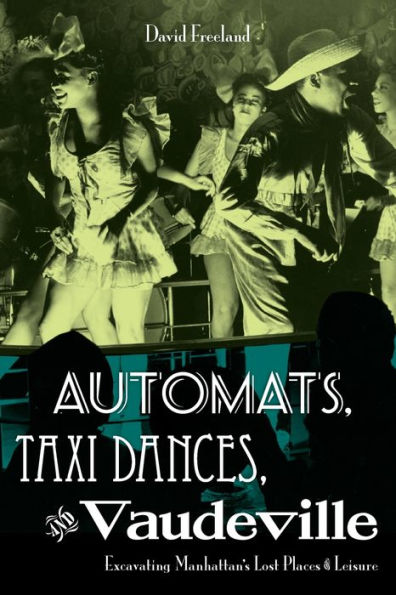"With an archaeologists eye and a storytellers wit [Freeland] roams from Chinatown to Harlemconcentrating on scenes of the citys nightlife a century ago during the vaudeville era but also reaching back into the nineteenth century as he summons up forgotten neighborhoods and personalities who gave old New York its raffish vigor."
Freeland’s affectionate, detail-packed tome about Manhattan’s forgotten pleasure centers—from dance halls to gambling dens—adds a lyrical song to the cacophony. Organized geographically and for the most part chronologically, the book explores eight neighborhoods—Chinatown, Chatham Square, the Bowery, the East Village, Union Square, the Tenderloin, Harlem and Times Square—via their entertainment centers, with the added hook that physical remnants of these historical hot spots still exist.”
• Time Out New York
“Freeland combines the detective acumen of a modern Sherlock Holmes and the exploratory curiosity of Indiana Jones as he uncovers forgotten but still visible treasures of Gotham’s offbeat and seamier underside. This physical genealogy of Manhattan’s historic nightlife will become an invaluable companion for anyone exploring New York’s neighborhoods.”
-Timothy J. Gilfoyle,author of City of Eros
“Only a reader made of stone will be able to resist the occasional longing for what used to be; but overall, Freeland’s headfirst dive into the past makes the experience seem utterly contemporary, vital and alive. He brings a scholar’s knowledge and a native New Yorker’s passion to the table.”
• The Villager
“Only a reader made of stone will be able to resist the occasional longing for what used to be; but overall, Freeland’s headfirst dive into the past makes the experience seem utterly contemporary, vital and alive. He brings a scholar’s knowledge and a native New Yorker’s passion to the table.”
• Downtown Express
Truly "the city that never sleeps," New York City has been known for two centuries for its ceaseless pace. Of course, entertainment venues are ultimately as ephemeral as they are exciting; yesterday's nightlife hot spot becomes today's abandoned building. David Freeland's Automats, Taxi Dances & Vaudeville rescues these monuments of leisure from oblivion, offering us glimpses into the once-bustling world of Gotham's German beer gardens, nickel silent movie theatres, burlesque houses, and all-night diners and bars. This carefully researched paperback will appeal to history buff fans of authors like Luc Sante and Timothy Gilfoyle.
Starred Review.
In its people and its real estate, New York maintains a complicated relationship with its past: though always moving forward, the city is also preoccupied with its grand old architecture, a refined sense of nostalgia and an idealized sense of times gone by. Still, few New Yorkers know much about the city's actual history. Historian and music journalist Freeland (Ladies of Soul) provides an excellent correction in this detailed exploration of Manhattan's lost leisure spots, from defunct 19th century Chinatown beer gardens to the earliest integrated theaters in Harlem. Along the way, Freeland unreels meticulous accounts of Manhattan's more fascinating and scandalous moments. New Yorkers past and present will learn much about parts of the city-buildings, neighborhoods, people and hot spots-long gone, or so transformed as to be unrecognizable. Focusing on five neighborhoods-Chinatown, Union Square/East Village, the Tenderloin, Harlem and Times Square-these stories provide a vivid cross-section of the city as a whole in ways a more generalized approach couldn't. Exceptionally well-written and researched, this volume will satisfy anyone curious about New York, or the way a modern metropolis builds and rebuilds itself to reflect the times.
Copyright © Reed Business Information, a division of Reed Elsevier Inc. All rights reserved.
Historian and music journalist Freeland (Ladies of Soul) shows us the palimpsest that is Manhattan: a volume of tales, many obscured and overwritten by newer stories, with much early material lost forever, but with parts that lurk obscurely, not entirely erased. A seeker like Freeland, who set forth both along New York's pavement and into its archival material, can discover many old stories, ripe with adventure, colorful personalities, and triumphs and sorrow. Stoked by his knowledge of local cultural and musical history, Freeland sought to "bring out of hiding" New York's obscured places, the half-visible fragments, that testify to earlier eras of the city's history of entertainment and leisure. Freeland explains that because popular culture is ever shifting and changing, and operates beyond the status quo, its built environment falls prey to destruction sooner than does that of government and finance. From Chinatown (beer gardens, Chinese theater, gang warfare) to the East Village and Union Square (the "Jewish Rialto," rooftop movie-making) to Tin Pan Alley, Times Square (the Automat, taxi dancers), and Harlem (jazz and ragtime on 133rd Street), Freeland turns his readers into intrepid time travelers. The richness of the New York stories he presents, in elegant prose, is more abundant than the actual brick and mortar that remain. His is a guidebook to the city's history, to what it has bequeathed us, even as much may be lost. VERDICT Highly recommended for all urban history buffs, New York City visitors and residents, and all studying the colorful history of urban American popular culture. [See the Behind the Book, p. 108.]—Margaret Heilbrun, Library Journal
"Freelands affectionate, detail-packed tome about Manhattans forgotten pleasure centersfrom dance halls to gambling densadds a lyrical song to the cacophony. Organized geographically and for the most part chronologically, the book explores eight neighborhoodsChinatown, Chatham Square, the Bowery, the East Village, Union Square, the Tenderloin, Harlem and Times Squarevia their entertainment centers, with the added hook that physical remnants of these historical hot spots still exist."
"Reading this book is like going on a walking tour with a really knowledgeable guide, who knows not only what building to point out but also what stories lurk behind the front door."






